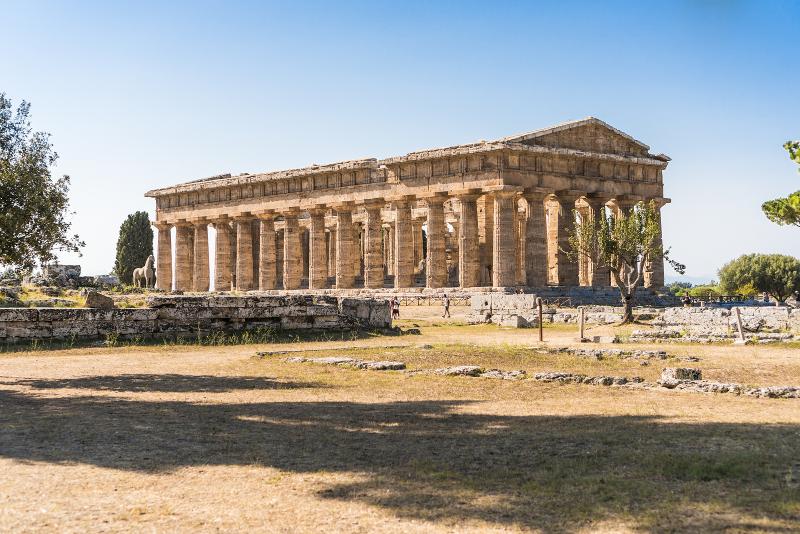Wonders of Italy: Paestum
ITA:

Use player to listen to Italian version
“You can’t trust books if you really want to understand these temples… you have to come here, walk among the ruins, and then everything will spring back to life…”
Thus wrote Goethe while visiting Paestum, home to one of Italy’s most incredible archaeological sites.
Founded by Greek colonists coming from Sybaris, on the Ionian coast of Calabria in 600 BC, Paestum was originally named Poseidonia, to honor Poseidon, the Greek God of the seas. The Greeks were looking for a new port on the Thyrrenian Sea to expand their trading power, which they did, while erecting buildings that have few equals in the world.
Indeed, Paestum, thanks to its three ancient Greek temples, some of the best preserved in the world, has been included by Unesco in its World Heritage list.
The most ancient temple dates back to 550 BC and is dedicated to Hera, the goddess of fertility and life; on the opposite side of town is the temple of Athena; the largest of the three is the temple dedicated to Poseidon, which is 60 meters long, 24 meters large and 18 meters high, the equivalent of a six-story building.
Paestum later became a Roman city (that’s when it took the name Paestum), and was abandoned in the Middle Ages. The ruins were rediscovered in the 1760s, but not fully excavated until the 1950s. After being discovered, Paestum became a popular destination on the Grand Tour.
Not as popular as the archeological site of Pompeii, located in the same southern Italian region of Campania, Paestum makes it easier to absorb the atmosphere of the place, if you take some time to walk among the ruins, especially at sunset, when the travertine columns reflect the light of the sun.
You can get to Paestum from Naples by train in about an hour. It’s then a 15-minute walk to the archeological area and the museum.
"Non ci si può fidare dei libri per capire davvero questi templi... bisogna venire qui, camminare tra le rovine, e allora tutto riprende vita..."
Così scrisse Goethe della sua visita a Paestum, sede di uno dei siti archeologici più straordinari d’Italia.
Fondata da coloni greci provenienti da Sibari, sulla costa ionica della Calabria, nel 600 a.C., Paestum era originariamente chiamata Poseidonia, in onore di Poseidone, il dio greco dei mari. I greci stavano cercando un nuovo porto sul Mar Tirreno per espandere il loro potere commerciale e ci riuscirono, erigendo nel frattempo edifici che hanno pochi eguali nel mondo.
Paestum, infatti, grazie ai suoi tre antichi templi greci, tra i meglio conservati al mondo, è stata inserita dall'Unesco nell’elenco del Patrimonio Mondiale dell’Umanità.
Il tempio più antico risale al 550 aC ed è dedicato ad Hera, dea della fertilità e della vita; sul lato opposto della città si trova il tempio di Atena; il più grande dei tre è il tempio dedicato a Poseidone, che è lungo 60 metri, largo 24 e alto 18, l'equivalente di un edificio di sei piani.
Paestum divenne in seguito una città romana (da qui prese il nome di Paestum), e fu abbandonata nel Medioevo. Le sue rovine furono riscoperte nel 1760, ma non completamente dissotterrate fino agli anni '50. Dopo essere stata scoperta, Paestum è diventata una meta ambita del Grand Tour.
Meno frequentata del sito archeologico di Pompei, situato anch’esso nella regione Campania del sud d’Italia, a Paestum è più facile assorbire l'atmosfera del luogo, soprattutto se ci si prende un po’ di tempo per passeggiare tra le rovine, in particolare al tramonto, quando le colonne di travertino riflettono la luce del sole.
Paestum si raggiunge in treno da Napoli in circa un'ora. L'area archeologica e il museo distano 15 minuti a piedi dalla stazione.











